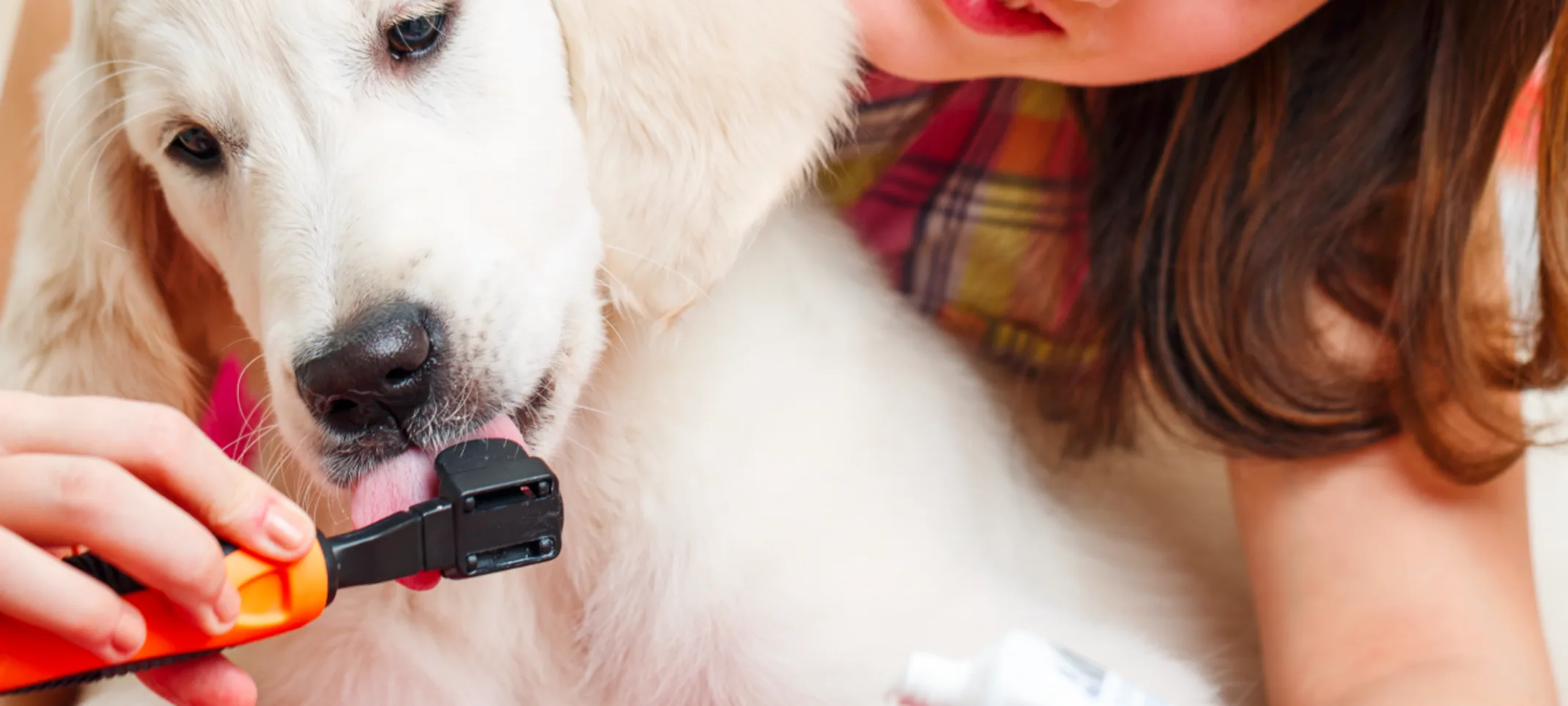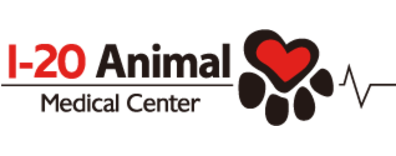I-20 Animal Medical Center
Pet Teeth Cleanings

Periodontal disease is the most common problem we see in veterinary medicine. Routine pet teeth cleanings at I-20 Animal Medical center keep your pet’s teeth looking and feeling great!
Periodontal disease is a strange sort of problem. While we used to blame the bacteria and plaque on the teeth as the culprits, veterinary dentists now have a greater understanding of what is really happening inside a pet’s mouth. Human dentists have noted for years that some people with very clean mouths still get gum disease while others with tartar- and plaque-covered teeth do not.
Research shows that it is actually our bodies’ reactions to the various bacteria in the mouth that determines whether or not we get bone loss and gum disease. If we are susceptible to overreacting to this invasion, we get attachment loss of the gums, then pockets around the teeth and finally bone loss. It is the overreaction to the bacteria that is the problem, not the actual bacteria. In a defensive posture against the bacteria, our bodies destroy our own collagen, which causes the connective fibers that hold our gums next to the teeth to give way. This leads to a pocket, which gathers more bacteria and therefore more reaction. Since bone can only live when it is covered by tissue, it starts to go away, too. It’s a nasty cycle. To break up this cycle, we must clean the pet’s teeth thoroughly and stop the body’s reaction to this invasion.
Chronic pet bad breath is a good indicator for periodontal disease. If your pet has smelly breath, it may be time for a dental cleaning. Here are some common questions I-20 Animal Medical Center’s clients have about pet dental cleanings.
Frequently Asked Questions: Pet Teeth Cleanings
Why should I take my dog or cat in for a dental checkup? His teeth look fine to me.medium Gum disease, bone loss, tumors, cysts and abscessed teeth are almost always found under the gum line. We can’t diagnose these problems without dental X-rays! In most cases, you only see the tip of the iceberg with the naked eye. A veterinary dentist is trained to see issues most pet owners don’t recognize.
Here are some common signs that a pet is struggling with dental disease:
Smelly breath
Dark stains on the teeth, especially near the gum line or sides of the teeth
Favors one side when chewing and/or hesitates when eating dry dog or cat food
Drools a lot
Bleeding at the gum line
Red, swollen gums, bad breath and tartar-covered teeth are signs of very unhealthy pet teeth.
How often should I have my pet’s teeth cleaned?
We don’t have a set schedule for pet dental cleanings like we do as humans. But some dog breeds are more likely to develop gum disease and tooth loss. Small breeds like Dachshunds, Yorkies, Terriers, brachycephalic breeds (flat-nosed breeds like Pugs and Bulldogs) and most toy breeds have a very high incidence of pet dental problems. These breeds typically need their teeth cleaned every year. Other breeds that have a lower incidence of gum and tooth problems might only need cleanings every three years.
If the teeth are shiny white and have no stains, and if your pet’s breath smells fine, then their teeth will most likely be low maintenance. Your I-20 Animal Medical Center veterinarian will recommend a thorough exam, X-rays and a teeth cleaning under anesthesia so you can establish a baseline and figure out just how often those teeth will need to be cleaned.
Do we really have to sedate my pet to clean the teeth?
Yes! On a very rare occasion, we have seen a dog (never a cat!) allow a dental cleaning while they are awake. But most of these awake cleanings are rudimentary and cursory. They never include putting digital X-ray sensors in the molar region or the use of ultrasonics to help clean, nor do they ever allow full-mouth probing for tissue pockets. If you want a thorough dental cleaning, then yes, your pet must be sedated.
What constitutes a good pet dental cleaning?
During a good, thorough dental cleaning, a skilled veterinary technician uses an ultrasonic scaler and hand instruments to remove all the tartar and calculus from above and below the gum line. Once the pet’s teeth are clean, the veterinary technician uses a fluoride paste to polish the teeth smooth, making them more resistant to future tartar development. medium
A periodontal probe and explorer are used during a post-cleaning examination. If a probe depth (pocket around the tooth) is greater than 2mm in dogs or 1mm in cats, this indicates that periodontal disease is present, and additional treatment may be necessary to save the tooth. X-rays, a comprehensive oral examination and charting are performed at the time of the teeth cleaning as well. Charting a pet patient’s mouth is the process of recording dental abnormalities in a pet’s medical record for future reference or to design a treatment plan.
What is included in a pet dental cleaning?
Physical exam: Your pet’s veterinarian will complete a physical exam to check for health issues that could inhibit an anesthetic procedure.
I.V. catheter and fluids: An I.V. catheter is placed to administer fluids and injections during the operation. Fluids administered through I.V. help protect the pet’s organs and support a quicker recovery from anesthesia. I.V. fluids are administered throughout the patient’s procedure, and the I.V. is removed during recovery.
Mild sedation and pain medication: A mild sedative is given to relax the pet patient. Research shows that administering pain medication prior to the procedure helps control pain and keeps the patient more comfortable, which allows for quicker recovery and healing.
Anesthesia: The patient is induced with a gas anesthesia, Isoflurane, and the pet patient is intubated. A steady flow of anesthesia is maintained throughout the procedure.
Specialized monitoring and warming: A technician constantly monitors the patient’s vital signs (blood oxygenation, respiration rate, temperature, heart rate and EKG with pulse oximetry) while the pet is under anesthesia. Pulse oximetry is a noninvasive method of monitoring the anesthetized patient and alerts the veterinary team if slight changes in normal vital signs occur. The patient’s temperature is maintained with a specialized warming unit that circulates warm air.
Oral exam and charting: An oral exam and dental charting are performed on the pet’s gums and each tooth to note and record overall dental health. Any dental and oral problems are noted.
Ultrasonic cleaning and polishing: Your pet’s veterinary technician uses an ultrasonic instrument to gently scale hard plaque from the teeth. After the plaque is removed, the veterinary technician polishes the teeth with a special paste and applies fluoride.
Sealant: Oravet, a sealant, is applied to prevent tartar buildup between pet dental cleanings.
Antibiotics: An injectable antibiotic is administered to prevent potential infection while the pet heals.
Patient recovery: Patients are monitored by a veterinary technician after the procedure is complete to ensure their smooth and gentle recovery.
Home care: You’ll receive instructions for home care during discharge from a veterinary technician. The dental team customizes dental plans for each patient, which encourages optimum dental care.
Will my pet have much pain?
Nope! Since most of our patients have gum disease, cracked or broken teeth or chronic ulcerations when they arrive, they tend to feel so much better when they leave. If a pet has undergone a major dental procedure, we do provide a long-term injection of pain medication to help them heal. I-20 Animal Medical Center’s clients tell us regularly that their dogs or cats were much more energetic after cleanings.
Are X-rays and blood work necessary for pet teeth cleanings?
X-rays and blood work are not included in the price of teeth cleanings. However, blood work is always recommended before any anesthetic procedure. Blood work is the only way to determine how well the organs are performing and to assesses the pet’s white and red blood cell count. X-rays are commonly performed with teeth cleanings, as they can reveal possible cavities between the teeth, detect bone loss and abscesses and verify cysts or tumors.
What about home care and maintenance?
Many of I-20 Animal Medical Center’s clients brush their dogs’ teeth, and we have special brushes and toothpaste available for those willing to tackle the job. Brushing can often be a challenge in the beginning, but those people who stick with it find it gets easier and easier as the dog becomes more cooperative over time. Many dogs will sit there and actually enjoy the experience eventually! The success of this endeavor lies more with your persistence than with the dog’s behavior.
Remember to be patient while starting a toothbrushing regimen. Use either a finger brush or a regular-sized toothbrush. Then, put some doggie toothpaste on the brush. While most vets push beef- or chicken-flavored toothpaste, we have found that dogs really enjoy vanilla as well, and it smells much better to us humans.
Start the brushing process by pulling back the dog’s lips and rubbing either the finger brush or the toothbrush against the outer sides of the teeth. At first, you may only get cooperation for a matter of seconds. Be patient! Also, offering up treats never hurts the process. A few seconds of brushing followed by a minute of love and treats makes for a much better experience than trying to hold your pet down with force.
Mainly concentrate on the outer surfaces on the upper and lower teeth and gums. Pets don’t get as much buildup on the inner surfaces. As you master the outsides, then you can move to the inside surfaces.
Keep with it. It can make the difference between a healthy pet and one that has major dental problems. Good luck!
Why choose I-20 Animal Medical Center for pet dental care?
I-20 Animal Medical Center is the only veterinary hospital in North Texas with a veterinarian that has been through three years of additional pet dental training and that has a human dentist on staff. No one else in the Metroplex has that sort of expertise in pet dental care.
We have a surgery suite and two operatories dedicated to pet dental procedures. If your human dentist has it, so do we! Our setup is second to none. From routine cleanings, fillings and crowns to jaw fractures and tumor removals, if it is dental, we do it with the expertise you’d expect from your own dental care.
To schedule a veterinary dental cleaning at I-20 Animal Medical Center, give us a call at 817.478.9238.
